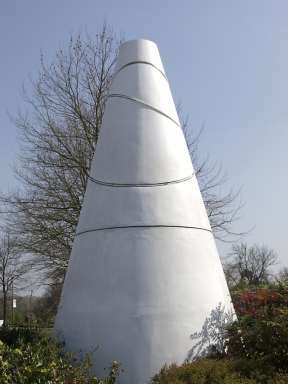White Koan by Liliane Lijn
 |
|
Let us know your thoughts about this sculpture on twitter @warwickuniartLink opens in a new window
Liliane Lijn's sculptures involve light and motion. At night, the upper part of White Koan, including its blue and white elipses of neon, revolves. It was originally programmed to respond to light levels, turning in the dusk, dark and dawn. Some students remember it suddenly switching itself on during dark winter afternoons. In recent years, this faculty has been replaced by a more precise timer that switches it on and off at particular times.
It was made at time of social change in the global north. Attitudes to women, to people of colour and to dominant religions were changing.
In the book published alongside the Mead Gallery exhibition that examined the first 30 years of Lijn's work, Professor David Alan Mellor examined the relationship between Lijn's koan forms - a pun on their shape - and the changes in society during the 1960s and 70s when feminism and new concepts of social justice became widespread. An initial inspiration was the white cones of ash that symbolised the Greek goddess Hestia that Lijn encountered when she moved to Greece. Emblematic of the domestic role of women, Lijn repurposed them to present a powerful goddess figure, dominating the public realm.
Mellor also connects these white figures to Robert Graves' re-examination of a pagan heritage which predates Judao-Christian traditions. 'The White Goddess' was first published in 1948 and then expanded and updated in editions published in 1952 and 1961. It presents an alternative to the male-dominant god of Judao-Christian traditions. Although criticism of the book includes the argument that it replaces one stereotype of women with another, the idea of creating alternative histories that centred on women began to prevail in this period.
The exploration of an alternative to Judao-Christian traditions by western societies during the 1960s and 70s is also referenced in the title of the work. 'Koan' is not only a pun on its shape but acknowledges the Zen Buddhist concept of a koan - a question without an answer - that is used in meditation.
The Warwick Koan has been at the centre of many campus myths that were borne out of political and social attitudes of students. As such, it has been regarded as emblematic of the university although firmly representing the views of students rather than that of the administration. It featured in a student strip cartoon and in other cartoons commenting on student life. It has been included in merchandise and is used as a landmark on maps. It has been central in many graduation photographs and when it was removed during Arts Centre refurbishment, Engineering students created their own koan and placed it outside Warwick Arts Centre so the tradition could continue. For a while, it had its own facebook and twitter accounts managed by unknown people. It is interesting to note that these accounts presented the Koan as a male figure with the atomic clock at Brno as its girlfriend.
The Covid disruption allowed many myths and traditions to disappear. The Koan remains an open, mythic figure, ready for the next generation of students to address it with their own ideas.
